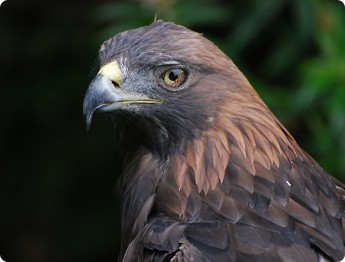
Golden Eagle
The report, “The illegal killing of birds of prey in Scotland in 2010”, indicates that persecution remains at high levels and continues to pose a serious risk to the long-term populations of some of Scotland’s most vulnerable birds of prey. The report also highlights the importance of dead birds found by walkers in remote areas although it is acknowledged that many suspicious bird deaths are likely to never be known about or investigated.
13 buzzards, 7 red kites, 2 peregrines and one white-tailed sea eagle were amongst those confirmed by Scottish Government testing to have been poisoned, in addition to the golden eagles above. A further eight birds of prey were also confirmed as victims of shooting, trapping or nest destruction.
However, as many of these crimes were discovered purely by chance, by walkers or birdwatchers, in remote areas of countryside, it’s likely that these figures represent “the tip of the iceberg.” Recent studies published in scientific journals investigating the populations of golden eagle, hen harrier and red kite indicate that this is indeed the case.
As in recent years, the majority of incidents involving banned poisons took place in areas managed for driven grouse shooting, particularly in the eastern and central Highlands and the southern Uplands of Scotland.
2010 also saw an increase in the confirmed use of highly toxic banned agricultural pesticides, such as Aldicarb and Carbofuran. Both chemicals have been previously linked with illegal poisoning cases involving birds of prey.
RSPB Scotland says that if this illegal behaviour continues, the Scottish populations of long-lived and slow breeding raptor species, including the golden eagle will continue to suffer and remain well below natural levels.
Stuart Housden, Director of RSPB Scotland said: “The criminal practice of illegally killing birds of prey remains a most serious conservation issue. Following welcome new measures to tackle this crime, we are working hard with the authorities and responsible land managers to see how we can use both intelligence and scientific information to better target enforcement against the perpetrators. We look forward to this yielding the visible results of an increase in the population and range of vulnerable species such as hen harrier, red kite, golden eagle and white-tailed eagle.”
Duncan Orr-Ewing, Head of Species and Land Management at RSPB Scotland, added: “We thank the public for their continued vigilance and encourage any suspected crimes to be reported quickly to the police and RSPB Scotland. Such reports were pivotal in finding illegally killed birds, sadly including four poisoned golden eagles, in 2010. Everybody can play a part in supporting efforts to bear down on these crimes in our countryside, which are so detrimental to some of Scotland’s tourism and other rural industries.”
